正在加载图片...

A Simple NMR Machine An NMR machine consists of: (1)A powerful,supercooled magnet(stable,with sensitive control, producing a precise magnetic field) (2)A radio-frequency transmitter(emitting a very precise frequency) (3) A detector to measure the absorption of radiofrequency by the sample. (4) A recorder(to plot the output). Figure 13-6(SLIDE) A simple NMR spectrum plots absorption on the y axis,and magnetic field strength on the x axis(Scale is in parts per million,and usually goes from 0- 10 ppm). The different positions of NMR absorptions are described as chemical shifts (δ) A chemical shift is defined as the difference in parts per million (ppm) between the resonance frequency of the observed proton and that of the tetramethylsilane (TMS)hydrogens. TMS is the most common reference compound in NMR,it is set at 8-0ppm. The chemical shift in ppm is calculated as the shift downfield from TMS in Hz,divided by the spectrometer operating frequency in MHz. So if a 60MHz spectrometer records a proton resonance at a frequency of 426Hz downfield from TMS,this corresponds to a chemical shift of 426/60 =7.10ppm Figure 13-9(SLIDE) Ch13NMR Page2 A Simple NMR Machine An NMR machine consists of: (1) A powerful, supercooled magnet (stable, with sensitive control, producing a precise magnetic field). (2) A radio-frequency transmitter (emitting a very precise frequency). (3) A detector to measure the absorption of radiofrequency by the sample. (4) A recorder (to plot the output). Figure 13-6(SLIDE) A simple NMR spectrum plots absorption on the y axis, and magnetic field strength on the x axis (Scale is in parts per million, and usually goes from 0- 10 ppm). The different positions of NMR absorptions are described as chemical shifts (δ). A chemical shift is defined as the difference in parts per million (ppm) between the resonance frequency of the observed proton and that of the tetramethylsilane (TMS) hydrogens. TMS is the most common reference compound in NMR, it is set at δ=0ppm. The chemical shift in ppm is calculated as the shift downfield from TMS in Hz, divided by the spectrometer operating frequency in MHz. So if a 60MHz spectrometer records a proton resonance at a frequency of 426Hz downfield from TMS, this corresponds to a chemical shift of 426/60 = 7.10ppm. Figure 13-9(SLIDE) Ch13 NMR Page2